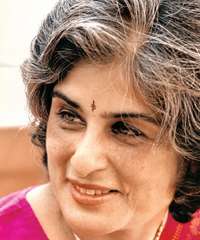
Arati Monappa, designer and owner of Serenity reveals her 10 rules of style.
1. There are two categories of people who have antiques — those who have inherited them and those who buy them because they are genuinely interested and have read up about them. It’s important to keep a piece from the past, that has been handed down from generation to generation. Especially because, antiques today are so expensive. So, if you’ve inherited any antique, keep it.
2. There are so many ways you can put your heirlooms to use. For instance, if you have a very old pashmina shawl, one that’s not good to be used by you, you may use it as a drape over your sofa. It enhances the furniture piece and two, becomes a talking point.
3. Antique pieces blend very easily into today’s modern homes. You may have a technology driven home, stocked with plasma TVs and other hi-tech gadgets and still add antique pieces like old copper or brass lamps or wood carvings. These pieces give character and personality to an otherwise stainless steel, shiny, impersonal house.
4. Talking about care for copper pieces, I use a powder called Pitambari. You just rub the powder over the item to make it gleam. There are more solid means of preserving these pieces too, like applying a coat of lacquer. For old wooden pieces, you may apply a coat of MRF’s wood coat polish. Or you may simply use a brush to remove the dust and rub linseed oil on it.
5.Antiques are undervalued. I see people throwing out items like old copper pots or beautifully woven baskets and replacing them with plastic mugs and plastic bags. There is a need for a certain education about the value of the old heirlooms. Not because of their value, but mainly because, plastic can’t be recycled and is not good for the environment. By buying plastic, you are adding to the junk.
6. There are quite a few old valuables that young couples interested in doing up their homes could buy. They could go for a lovely ceramic pottery piece or pick up old lamps. An old lamp in the corner is enough to add character to the living room. Old textiles are another option. For instance, your grandmother’s old woven sari could make for a beautiful framed piece of art, in the hall.
7. My store Serenity, is a good example of how you can bring the old into the new. We’ve re-used old glass panes, doors and grills for the interiors. So, even if its a modern five- year-oldbuilding, it’s got all these old elements like granite pillars, attangadi tiles for the floor, old mirrors and more.
8. Bangalore has quite a few places where you could go hunting for antiques. There’s Thar Gallery in Indiranagar. I believe Raintree carries a range of old furniture. Then of course, you have Russell Market, where you still have little shops where you can pick up an interesting salvaged piece.
9. I like to spend money on carpets and artworks. I think these two are very important in a home and add a whole new character to it. A painting doesn’t have to be expensive. It could also mean indigenous art like a mithila, madhubani or warli art.
10. I am very fond of carpets for the intricacy of their weaves. I am partial to porcelain and ceramic too. I like my teacups and teapots!
source: http://www.dnaindia.com / Home> Lifestyle> Report / by Mahalakshmi Prabhakaran / Place:Bangalore, Agency:DNA / Thursday, December 01st, 2011






